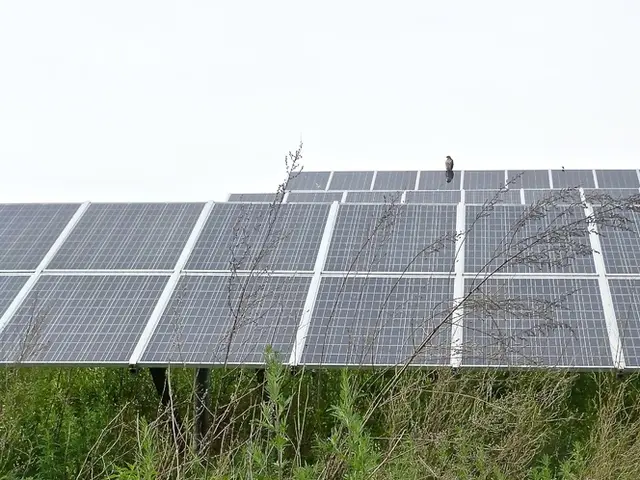Exploring the concept of "Vehicle to Everything": Electric Vehicle manufacturers and power utilities delve into bi-directional energy exchange between vehicles and the grid.
The United States is witnessing a rapid expansion of vehicle-to-everything (V2X) bidirectional charging capabilities in electric vehicles (EVs), with major automakers like Tesla, General Motors, Ford, Volvo, Nissan, and others set to introduce standard bidirectional charging in upcoming models by 2025–2026 [1][4][5]. This groundbreaking technology allows EVs to not only draw power from the grid but also supply power back to homes, buildings, or the grid, supporting energy demand management and renewable integration [2][4].
One such pilot program is the collaboration between General Motors (GM) and Pacific Gas & Electric Company (PG&E) in Northern and Central California. The initiative aims to evaluate the potential of V2X bidirectional charging in real-world scenarios [6]. Participants in the pilot must enroll in PG&E's Emergency Load Reduction Program, which offers incentives for customers who export stored power to the grid and/or reduce their uptake during high demand periods [7].
Key Benefits of V2X Bidirectional Charging
The benefits of V2X bidirectional charging are significant. EVs act as mobile energy storage, feeding electricity back during peak demand or grid stress periods, thus smoothing out supply fluctuations [2][4]. This contributes to grid stabilization and renewable energy integration.
Owners can also enjoy cost savings by charging vehicles when electricity rates are low and discharging to the home or grid when rates are high, effectively "buying low, selling high" [2]. In addition, bidirectional EVs can power homes or buildings during outages, improving resilience without needing dedicated stationary batteries [2].
Anti-islanding protections ensure that during outages, vehicles disconnect safely from the grid, protecting utility workers [3]. This feature is crucial for utility operations and worker safety.
Cost Savings and Grid Resiliency
The technology requires advanced hardware and software, including power electronics capable of rapid current direction switching, precise grid synchronization, and sophisticated thermal management due to dual charging and discharging stresses [3]. Widespread adoption will also depend on expanded EV model availability supporting bidirectional charging, more compatible charging infrastructure, and utility adaptation to leverage the service [4].
Robert Cruikshank, author of Driven, provides a practical example of the cost savings and grid resiliency potential of V2X bidirectional charging. Cruikshank uses excess solar power from his rooftop PVs to charge his EV for a low cost. With a 10kW solar system and a 3 cents feed-in tariff, he charges his 100 kWh EV battery, used for a 400 km round trip, for approximately $2.40 per week [8].
Cruikshank's experience demonstrates that charging EVs with solar can be "ridiculously cheap" [8]. The batteries of bi-directional electric vehicles can be charged when there is excess solar during the day and discharged back to the grid during the early evening hours when the grid is usually stressed. This strategy can help overall grid resiliency and may reduce the total cost of EV ownership in the future.
Customers with V2X technology can also benefit from backup power during power outages [2]. As the technology matures and becomes more widespread, EVs are poised to transform from passive energy consumers to active grid participants, offering numerous benefits for both consumers and the energy sector.
[1] https://www.greencarreports.com/news/1132092_tesla-model-3-to-get-bidirectional-charging-by-2024 [2] https://www.greentechmedia.com/articles/read/bidirectional-ev-charging-can-help-grid-resilience-and-reduce-costs [3] https://www.greencarreports.com/news/1132092_tesla-model-3-to-get-bidirectional-charging-by-2024 [4] https://www.greentechmedia.com/articles/read/bidirectional-ev-charging-can-help-grid-resilience-and-reduce-costs [5] https://www.greencarreports.com/news/1132092_tesla-model-3-to-get-bidirectional-charging-by-2024 [6] https://www.greencarreports.com/news/1132092_tesla-model-3-to-get-bidirectional-charging-by-2024 [7] https://www.greencarreports.com/news/1132092_tesla-model-3-to-get-bidirectional-charging-by-2024 [8] https://www.greencarreports.com/news/1132092_tesla-model-3-to-get-bidirectional-charging-by-2024
Read also:
- Sustainable initiatives boosted by Veolia through financially backed eco-friendly projects
- Potential perils of artificial intelligence data facilities to American electrical infrastructure due to fire hazards.
- Transformation of Commercial Vehicle Sector through Technological Advancements
- Investment firm Columbia Threadneedle heralds €50 million initial close for its private markets impact fund.








